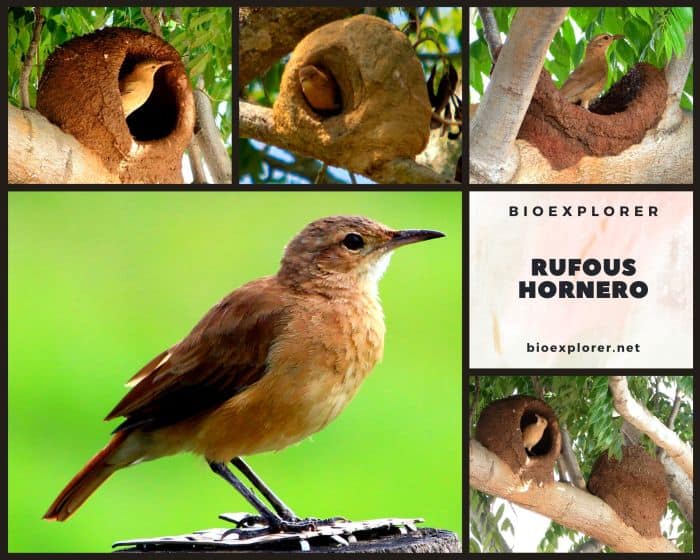
| Animalia | Aves | Passeriformes | Furnariidae | Chordata | Furnarius rufus |
The rufous hornero (Furnarius rufus), a remarkable bird, stands out for its unique characteristics and deep-rooted cultural significance. It can be found across eastern South America in countries such as Argentina, Brazil, Bolivia, and Paraguay, This species belongs to the Furnariidae family, which are commonly referred to as ovenbirds due to the fact that horneros’ nests roughly resemble an oven-like structure. In particular, the rufous hornero is often referred to as the “red ovenbird” due to its reddish brown plumage.
- It’s not just any bird; it’s the national bird of Argentina.
- Its presence in local folklore and traditions undeniably symbolizes national pride and identity.
- Due to its unique behavior and nesting habits, birdwatchers and enthusiasts often regard it as a must-see.
Let us now explore the fascinating details of this remarkable South American bird!
Table of Contents
- Physical Description
- Distribution and Habitat
- Behavior and Ecology
- Unique Nesting Habits
- Taxonomy and Classification
- Cultural Significance
- Conservation Status and Threats
- Names and Taxonomy in Different Languages and Concepts
- Tips for Birdwatchers and Enthusiasts
- Frequently Asked Questions
- Conclusion
- Additional Resources and References
Physical Description
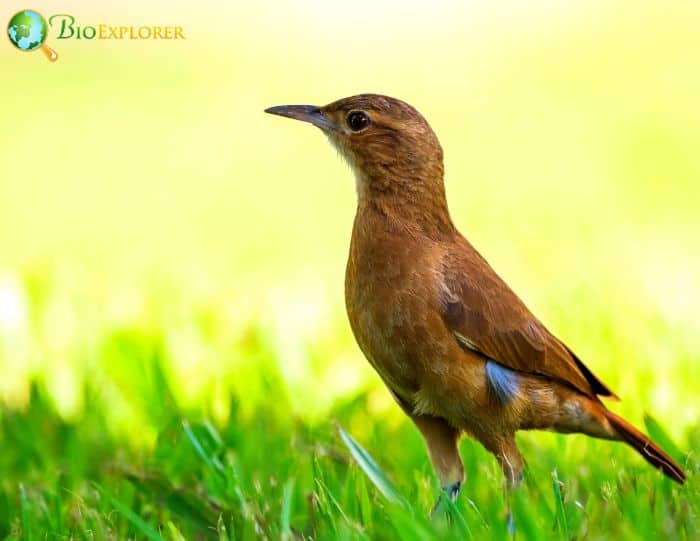
The Rufous Hornerois is a captivating specimen within the avian world, boasting features that make it distinctive and representative of its South American roots.
- Size: The Rufous Hornero typically measures 7 to 8 inches in length. This medium-sized stature allows it to maneuver through its habitats with agility, whether it’s fluttering between trees or foraging on the ground.
- Color: Its plumage is a harmonious blend of rufous-brown on the upperparts, transitioning to lighter underparts. This coloration not only provides it with a natural camouflage amidst the earthy tones of its environment but also gives it its iconic name. The rufous crown and straight bill further accentuate its appearance, making it easily recognizable to those familiar with the species.
- Distinguishing Features: The rufous hornero has distinct vocalizations – a series of loud, melodious chirps consisting of “kweep” notes that set it apart from other birds in the South American wilderness.
- Comparison with Similar Species: The world of birds is vast, and within the Furnariidae family, to which the Rufous Hornero belongs, there are many species with overlapping features. Some birds might share the earth-toned color palette of the Rufous Hornero, while others might have similar sizes. However, few can claim the distinctive combination of features that the Rufous Hornero possesses. Its nesting habits, in particular, are unparalleled, making it stand out even amidst its closest relatives.
Distribution and Habitat
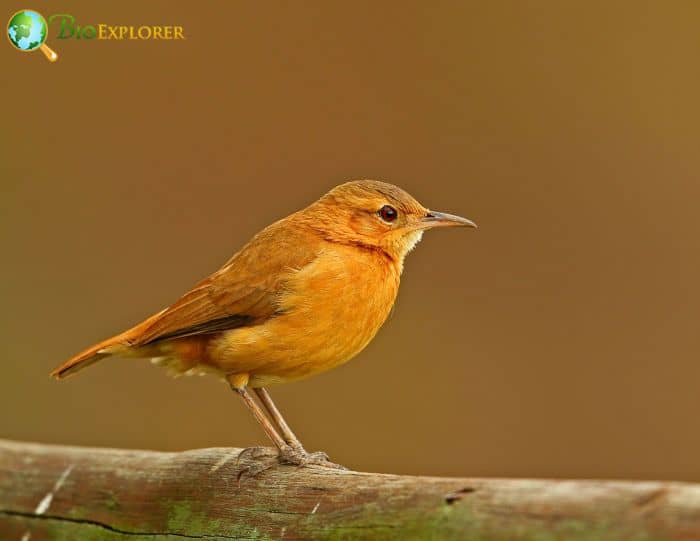
As mentioned previously, this species is spread across South America, primarily situated in Brazil, Argentina, Bolivia, Paraguay, Uruguay and other nearby countries. It is most commonly found in the following habitats:
- Savannas: These grassland ecosystems, dotted with occasional trees, provide the bird ample space to forage and nest.
- Second-growth scrub: These areas, characterized by shrubs and small trees, offer the Rufous Hornero shelter and abundant food sources.
- Pastures: Open fields, often used for grazing, are another favorite. Here, the bird can often hop around, searching for insects.
- Agricultural land: Surprisingly, the Rufous Hornero has adapted to human-altered landscapes, finding sustenance and nesting spots amidst cultivated fields.
Synanthropic Nature and Adaptability
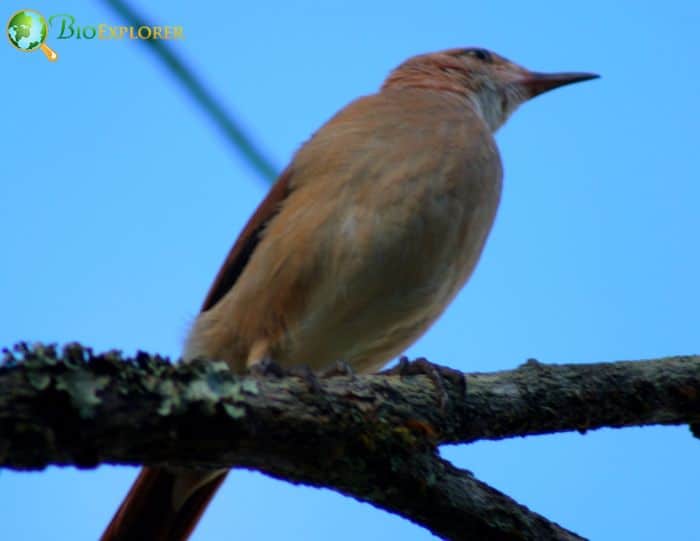
One of the most commendable traits of the rufous hornero is its synanthropicWhat is synanthropic?Synanthropic describes animals that thrive in human-altered environments, such as cities or farms. nature. This means that although the species is wild, it has evolved to associate with humans. As such, these birds often live near and benefit from human-altered environments such as urban areas, parks, and gardens. In fact, they often build their nests on man-made structures such as telephone poles or fence posts.
Behavior and Ecology
Daily Activities and Feeding Habits
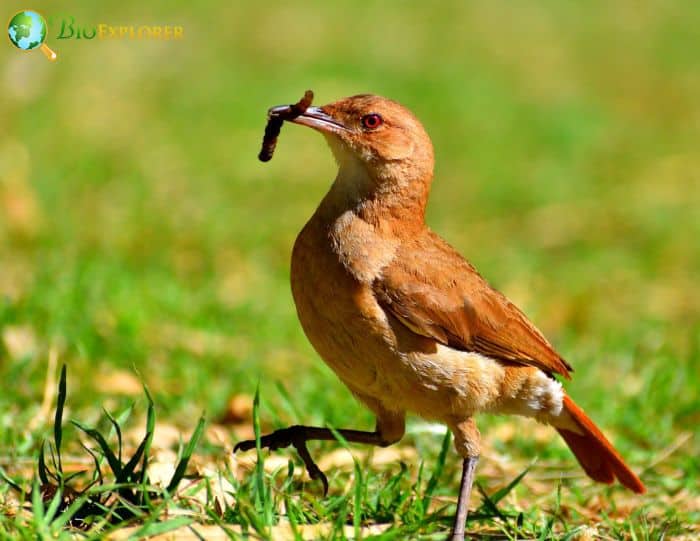
The Rufous Hornero is an early riser, often seen active at the break of dawn.
- Its day is filled with activities, from foraging on the ground to fluttering between branches. Its diet primarily consists of insects (e.g., beetles, ants, spiders, etc.), which it skillfully catches using its sharp beak.
- Occasionally, it indulges in seeds or small fruits, especially when insects are scarce.
- The bird’s keen sense of sight and hearing aids it in locating its prey, even amidst dense vegetation.
Mating Rituals and Courtship Behaviors
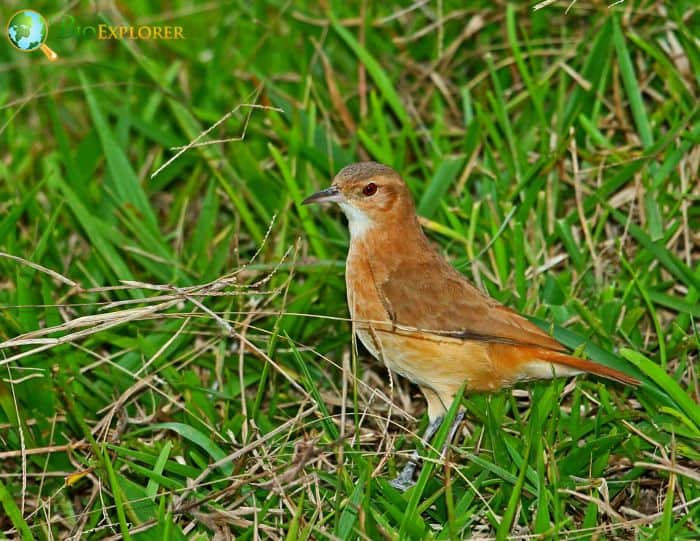
The world of the Rufous Hornero is filled with melodic songs and intricate dances, especially during the mating season.
- Males and females often engage in duets, with the former having a faster trill, while the latter has a slower trill.
- During these duets, the birds often also engage in aerial displays, showcasing their agility and strength.
- Once a pair is formed, they often stay monogamous, working together to build their “oven-like” nests.
- Beyond being architectural marvels, these nests are also a testament to the pair’s bond, as both partners contribute to its construction.
Interactions with Other Species
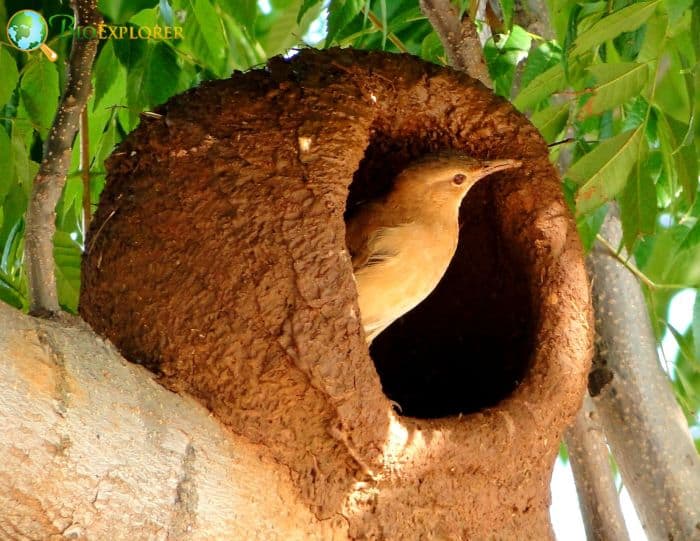
The Rufous Hornero, while primarily a peaceful bird, has its share of interactions with other species.
- Its sturdy and safe nests often attract other birds looking for a home. It’s common to find other species, like the Furnariidaefamily members, trying to occupy a Hornero’s nest.
- While the Rufous Hornero is generally tolerant, it can become territorial if its nest or young ones are threatened.
- Beyond birds, the Rufous Hornero also interacts with various insects and small animals, either as prey or as fellow inhabitants of its ecosystem.
The behavior and ecology of the Rufous Hornero offer a fascinating glimpse into the life of this unique bird, revealing a world of songs, dances, and intricate relationships.
Unique Nesting Habits
The Rufous Hornerostands out in the avian world for its rufous-brown plumage, melodious calls, and unparalleled nesting habits. These nests often likened to rustic ovens, are a testament to the bird’s architectural prowess and adaptability.
Description of the Oven-like Mud Nests
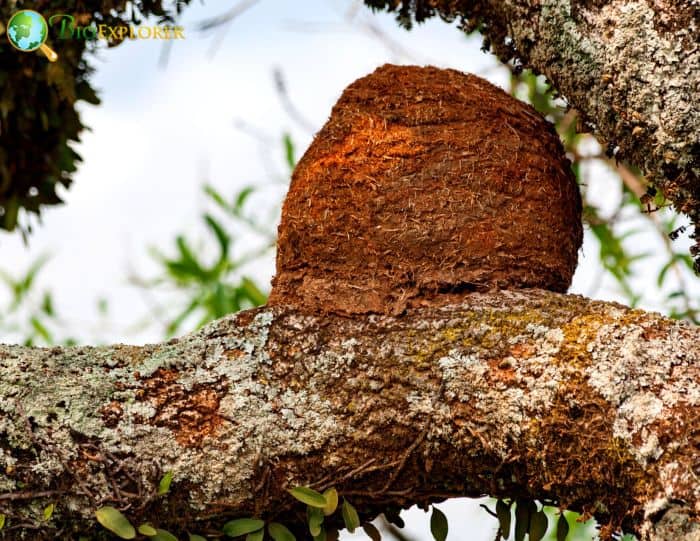
At first glance, the nests of the Rufous Hornero might seem like a random mound of mud.
- However, a closer look reveals a meticulously crafted structure. Made primarily from wet mud (but also with clay or plant matter in some cases), these nests are shaped like domes, with a small entrance leading to a spacious chamber inside.
- The thick nest walls provide insulation against the elements.
- As the mud dries over time, the nest becomes a sturdy, weather-resistant home capable of withstanding rain and heat.
Importance and Function of These Nests
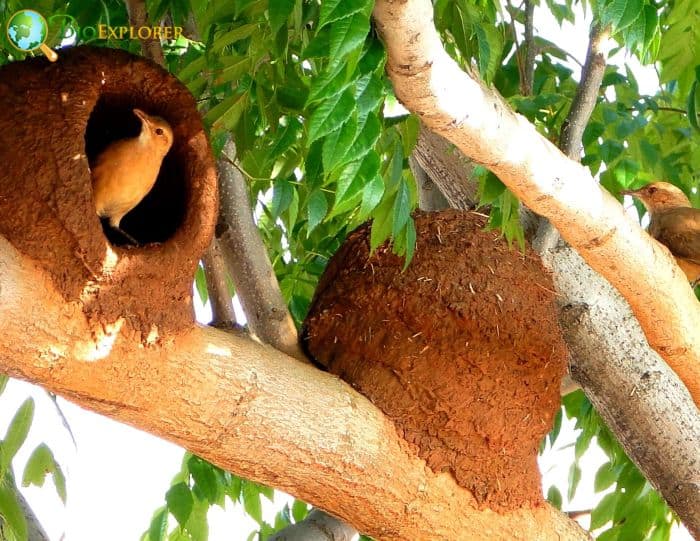
The oven-like design of Rufous Hornero’s nest is not just for show; it serves multiple purposes:
- Protection: The thick walls are a barrier against predators, ensuring the bird’s eggs and fledglings are safe.
- Insulation: The design ensures that the internal temperature remains relatively stable, protecting the inhabitants from extreme weather conditions.
- Longevity: Unlike many other birds’ nests that deteriorate after a single breeding season, the Rufous Hornero’s mud nests can last for years, often being reused or taken over by other species.
How and Where They Build Them?
Building a nest is a labor-intensive process for the Rufous Hornero.
- Both the male and female participate, gathering wet mud and molding it bit by bit. The construction can take several weeks, with the birds working diligently to shape and perfect their home.
- The primary consideration is safety, so they often choose elevated spots and are free from immediate threats.
Taxonomy and Classification
Diving into the world of avian taxonomy, the Rufous Horneroholds have a significant position, intricately linked to various species and subspecies, painting a vivid picture of its evolutionary journey.
Relation to the Crested Hornero and Other Relatives
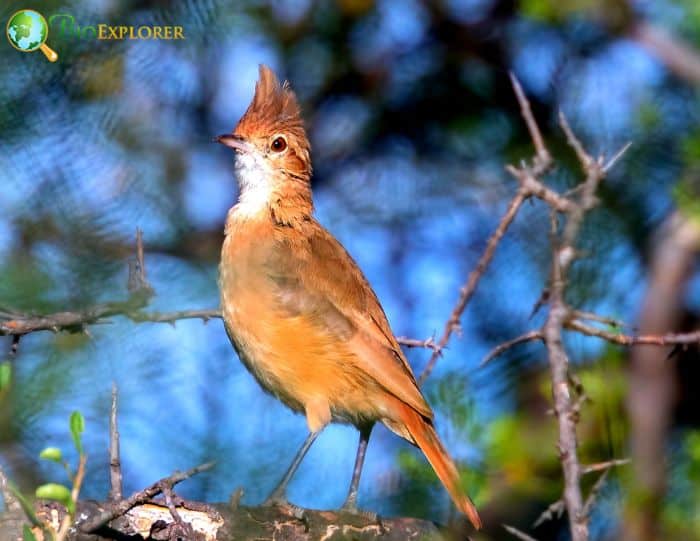
The rufous hornero, scientifically termed Furnarius rufus, shares its lineage with several other birds within the Furnariidae family. A notable relative is the crested hornero. While both share similar behavior and habitat preferences, distinct morphological differences (e.g., vocalizations, nesting habits, and plumage patterns) set them apart.
Overview of the Four Accepted Subspecies
The rufous hornero has four recognized subspecies split based on slight differences in their physical attributes (e.g., size, plumage, vocal patterns):
- Furnarius rufus rufus: Predominantly found in Brazil, Uruguay, and Argentina.
- Furnarius rufus albogularis: Native to Brazil.
- Furnarius rufus commersoni: Mainly located in Brazil, Argentina, and Bolivia.
- Furnarius rufus schuhmacheri: Found exclusively in Argentina and Paraguay.
Evolutionary History and Genetic Studies
- Genetic studies suggest that its ancestors diverged from other members of the Furnariidae family several millennia ago.
- Over time, distinct subspecies emerged as the bird adapted to diverse habitats and faced various environmental challenges.
- Modern genetic tools and techniques continue to shed light on its evolutionary trajectory, revealing intricate details about its lineage, migration patterns, and adaptability.
Cultural Significance
The rufous hornero holds a significant place in South America culture, particularly in Argentina. As the national bird of the country, the rufous hornero is depicted on the 1000 peso note, on top of its distinctive “oven-like” nest.
Role in Argentine and Uruguayan Folklore and Traditions
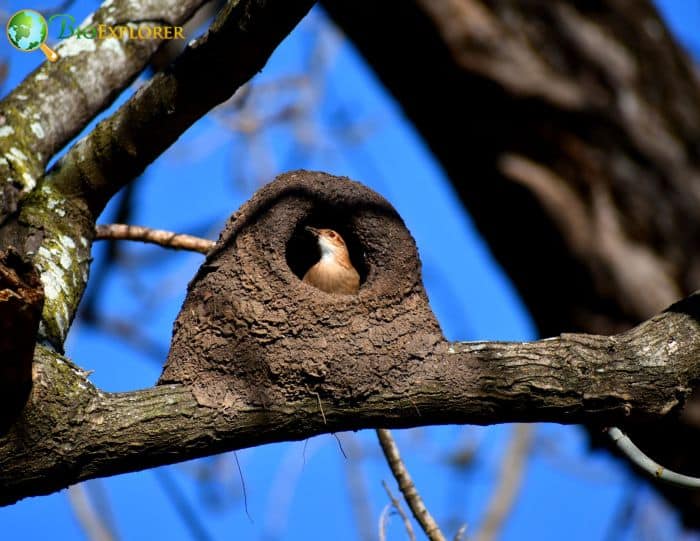
- Argentinian folk tales often portray this bird as a diligent worker, drawing parallels with its meticulous nest-building habits.
- Songs and dances from rural communities incorporate its melodious calls to celebrate its resilience and determination.
- Children grow up listening to stories where Rufous Hornero plays a vital role in teaching values such as hard work, perseverance, and unity.
Importance in Local Ecosystems and Human Communities
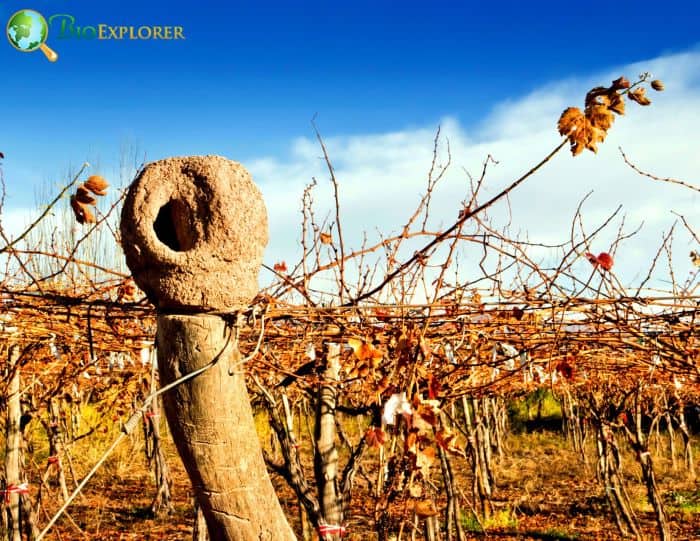
The Rufous Hornero holds importance beyond mere folklore in local ecosystems and human communities.
- This bird plays a role as an insectivore by helping control pest populations, greatly benefiting agricultural communities. Its distinctive mud nests, often constructed on man-made structures, represent the coexistence of humans and nature.
- Farmers view the bird’s presence as a sign indicating a bountiful harvest. Moreover, its ability to adapt to environments makes it a familiar sight in cities, bridging the gap between city dwellers and the natural world.
Conservation Status and Threats
While widespread and adaptable, the Rufous Hornero is not immune to the challenges of changing environments and human activities. Understanding its conservation status and threats is crucial for ensuring its continued presence in South America’s landscapes.
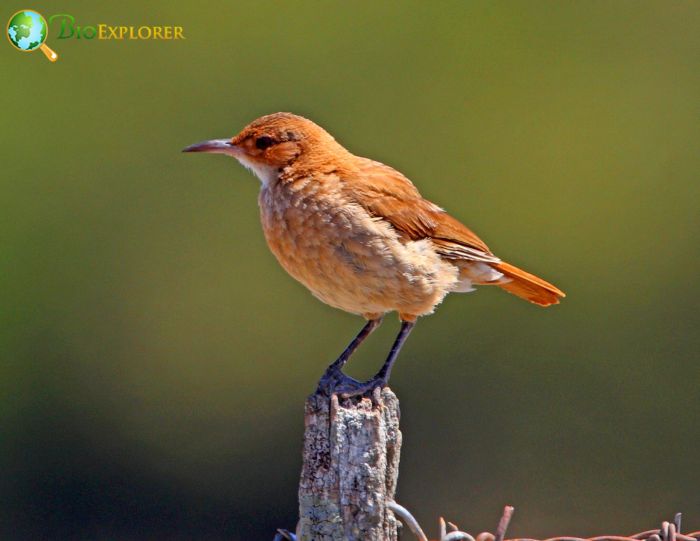
Current Conservation Status
The Rufous Hornero is classified as Least Concernon the IUCN Red List. This classification indicates that, currently, the species is not facing immediate extinction risks. Its adaptability to various habitats, including urban areas, has played a role in its stable population numbers.
Major Threats and Challenges
Despite its current status, the Rufous Hornero faces several challenges:
- Habitat Loss: Urbanization and agricultural expansion lead to the loss of natural habitats, pushing the species to adapt to new environments.
- Pesticides: In agricultural areas, pesticides can reduce insect populations, impacting the bird’s primary food source.
- Climate Change: Altered weather patterns can affect the bird’s breeding cycles, food availability, and nesting habits.
Efforts to Protect and Conserve the Species
Recognizing the importance of the Rufous Hornero in ecosystems and culture, several initiatives are in place:
- Awareness Campaigns: Local communities are educated about the bird’s significance and its role in pest control.
- Habitat Restoration: Efforts are made to restore natural habitats, ensuring the bird has ample space to forage and nest.
- Research: Ongoing studies monitor the bird’s population, migration patterns, and health, providing data for conservation strategies.
Rufous Hornero’s resilience is a beacon of hope in a rapidly changing world. However, concerted efforts from communities, governments, and conservationists are essential to ensure its songs continue to resonate across South America.
Names and Taxonomy in Different Languages and Concepts
The Rufous Hornerois is recognized and revered across various cultures, each attributing a unique name that resonates with local linguistic nuances. Additionally, its classification in the avian world is shaped by taxonomic concepts from esteemed organizations.
Names in Various Languages
- English: Rufous Hornero
- Catalan: Fornari Roig
- Czech: Pečenář Rudozobý
- Danish: Rødovnsmester
These names, while diverse, all allude to the bird’s distinctive characteristics, especially its rufous coloration and unique nesting habits.
Tips for Birdwatchers and Enthusiasts
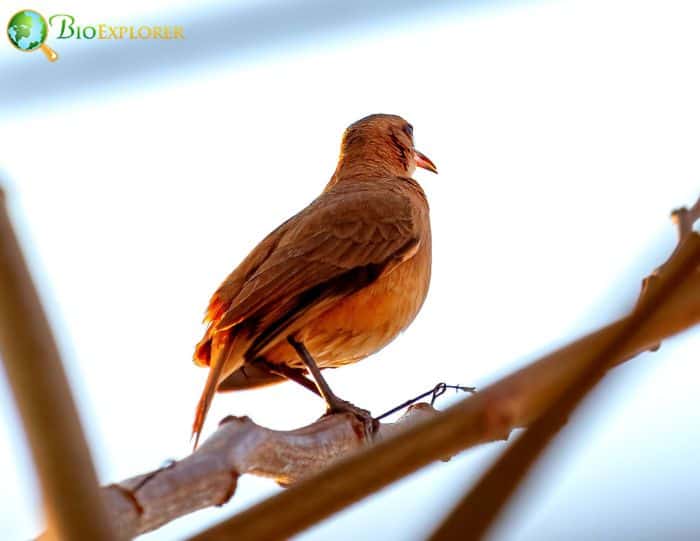
The Rufous Hornerois is a must-see for those passionate about avian wonders. Its distinctive features and behaviors make it a delightful subject for observation. Here are some tips to enhance your birdwatching experience:
Best Places and Times to Spot the Rufous Hornero
- Season: While the bird is a year-round resident in most of its range, the breeding season, which spans from September to December, offers unique opportunities to observe courtship rituals and nesting behaviors.
- Time of Day: Early mornings and late afternoons are prime times. During these hours, the Rufous Hornero is most active, foraging for food or engaging in social behaviors.
How to Identify Them Among Other Birds?
- Physical Features: Look for its rufous-brown plumage, straight bill, and distinctive crown. Its medium size, coupled with its coloration, makes it stand out.
- Nesting Habits: The Rufous Hornero’s oven-like mud nests are a dead giveaway. Spotting one of these nests can often lead you to the bird itself.
- Vocalizations: The bird’s calls are a series of melodious chirps. Familiarizing yourself with its vocal patterns can help identify it even if it’s not immediately visible.
- Behavior: The Rufous Hornero often hops on the ground, foraging for insects. Its movements are agile, and it frequently flits between low branches.
Equipped with these tips, birdwatchers and enthusiasts can enhance their chances of spotting and appreciating the Rufous Hornero, delving deeper into the world of this remarkable bird.
Frequently Asked Questions
What does the rufous hornero symbolize?
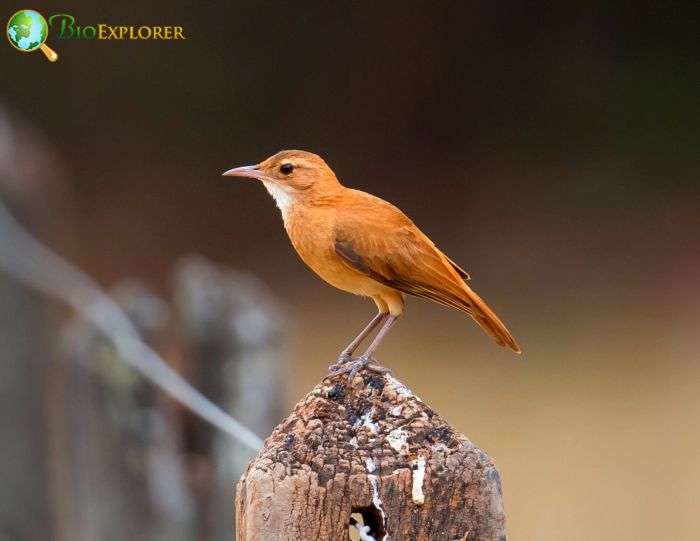
The Rufous Hornero symbolizes diligence, adaptability, and architectural prowess, primarily due to its meticulous nest-building habits. In countries like Argentina and Uruguay, it also stands as a symbol of national pride and identity, representing the region’s rich biodiversity and cultural heritage.
How does the rufous hornero incubate its eggs?
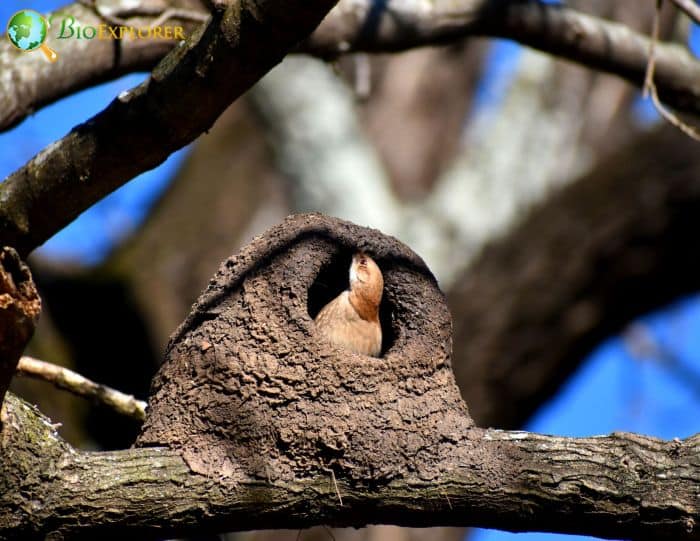
Both parent birds share the responsibility to incubate eggs. Once the eggs are laid in the nest, the parents take turns to keep them warm. This process contributes to the hatching of young birds or chicks.
How do the young rufous hornero birds develop?
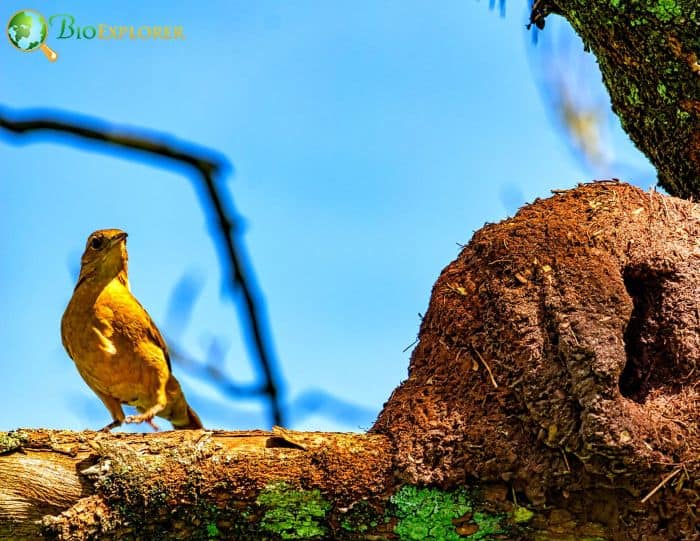
After hatching, the chicks are fed by both parents within their parental territory. When the young birds mature, they may often stick around their birthplace, sometimes even occupying older nests.
Where can I find detailed species accounts for the rufous hornero?
Detailed species accounts for the rufous hornero can be found in renowned publications such as “Handbook of the Birds of the World” by del Hoyo, J., A. Elliott, and D.A. Christie. Lynx Edicions also has extensive information on this bird.
![]()
Conclusion
The rufous hornero, a symbol of South America’s rich avian diversity, is a testament to nature’s wonders. Going beyond its beauty and unique behaviors, the rufous hornero plays a pivotal role in its ecosystem. As an insectivore, it aids in maintaining ecological balance, and its adaptability to wild and urban landscapes showcases nature’s resilience in the face of change.
However, like many of nature’s marvels, the Rufous Hornero’s continued presence is not guaranteed. As habitats change and challenges arise, the need for conservation becomes paramount. It’s not just about preserving a species but about safeguarding a legacy, a story that intertwines nature, culture, and history.
For those who have witnessed the Rufous Hornero in its natural habitat, the experience is often transformative. And for those yet to encounter this avian wonder, the journey awaits.
Let’s come together, not just in admiration but in action, ensuring that the songs of the Rufous Hornero continue to resonate for generations to come.
Additional Resources and References
For those keen on delving deeper into the world of the Rufous Hornero, here are some invaluable resources:
- eBird: A comprehensive database on bird sightings and information.
- NatureServe: Offers insights into the bird’s conservation status and distribution.
- ITIS: The Integrated Taxonomic Information System provides a detailed classification.
Suggested Readings and Documentaries
- “Birds of South America” by Robert S. Ridgely (Vol-1 | Vol-2 | More books by Robert S. Ridgely).
- “Wings Over the Pampas” – A documentary exploring the avian wonders of South America.
![]()










